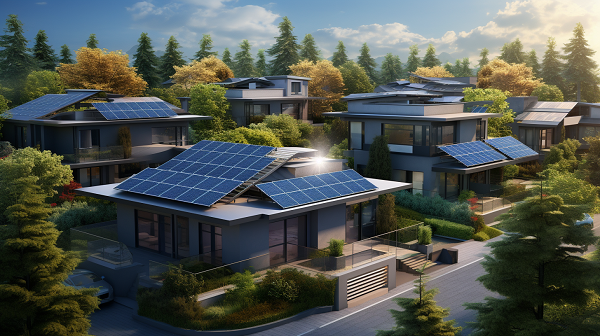As Europe grapples with energy challenges, particularly during the winter months, solar home energy storage has emerged as a viable solution to meet household energy needs sustainably and economically. The integration of solar photovoltaic (PV) systems with home energy storage not only reduces dependence on the grid but also offers long-term financial benefits. This article explores the necessary investment for adopting solar home energy storage in Europe and the future returns, highlighting real policy incentives from various European countries that enhance the viability of such investments.
Necessary Investment in Solar Home Energy Storage
Initial Costs
The initial investment for a solar home energy storage system primarily includes the cost of solar panels, a home battery system, installation, and ancillary equipment like inverters and monitoring systems.
- Solar Panels: The average cost of residential solar panels in Europe ranges from €4,000 to €6,000 for a 4 kW system, sufficient for an average household.
- Home Battery Systems: The cost of battery storage systems varies based on capacity and technology. Lithium-ion batteries, the most common type, range from €4,000 to €8,000 for capacities between 5 kWh and 10 kWh.
- Installation and Equipment: Installation costs and additional equipment can add another €1,000 to €3,000 to the total investment.
Technological Advancements
Advancements in solar and battery technologies are gradually reducing costs. Increased efficiency and economies of scale in production are making these systems more affordable for homeowners.
Future Returns
Energy Cost Savings
By generating and storing their own electricity, homeowners can significantly reduce or even eliminate their electricity bills. Excess energy generated during peak sunlight hours can be stored and used during the evening or on cloudy days, maximizing self-consumption.
Return on Investment (ROI)
The ROI for solar home energy storage systems can be substantial over the system’s lifespan, typically 20-25 years for solar panels and 10-15 years for batteries.
- Payback Period: The average payback period ranges from 7 to 12 years, depending on energy prices, system costs, and available incentives.
- Long-term Savings: After recouping the initial investment, homeowners can enjoy virtually free electricity, leading to significant savings over the remaining life of the system.
Increase in Property Value
Properties equipped with solar energy systems often see an increase in market value. Energy-efficient homes are attractive to buyers, potentially leading to a higher resale value.
Environmental Benefits
Investing in solar energy reduces carbon footprint by decreasing reliance on fossil fuels. This contribution to environmental sustainability is an added intangible return on investment.
Policy Incentives from Relevant Countries
European governments have implemented various incentives to promote the adoption of renewable energy technologies. These incentives enhance the financial attractiveness of investing in solar home energy storage.
Germany
- KfW Programs: The KfW Development Bank offers low-interest loans and grants for renewable energy projects, including solar PV and battery storage systems. Homeowners can access financing through programs like the KfW Renewable Energy Programme.
- Feed-in Tariffs: Under the Renewable Energy Sources Act (EEG), Germany offers feed-in tariffs that pay homeowners for excess electricity fed back into the grid. Although rates have decreased, the EEG 2021 amendment continues to support small-scale solar installations. Federal Ministry for Economic Affairs and Energy – EEG 2021
United Kingdom
- Smart Export Guarantee (SEG): Implemented in January 2020, SEG requires energy suppliers to pay homeowners for excess electricity exported to the grid. Rates vary by supplier, incentivizing self-generation and exportation of renewable energy. Ofgem – Smart Export Guarantee
- VAT Reduction: As of April 2022, the UK government announced a zero rate of VAT on the installation of energy-saving materials, including solar panels and batteries, for the next five years. GOV.UK – Spring Statement 2022
France
- Tax Credits (Crédit d’Impôt pour la Transition Énergétique – CITE): Homeowners can claim a tax credit for a percentage of the cost of renewable energy installations, including solar panels. While CITE was replaced by MaPrimeRénov’ in 2020, subsidies continue for energy renovations. Service-Public.fr – MaPrimeRénov’
- Feed-in Tariffs: France offers feed-in tariffs through contracts with EDF (Electricité de France) for solar energy, providing a fixed purchase price for electricity exported to the grid over 20 years. EDF OA Solaire
Spain
- Self-Consumption Incentives: Spain has reformed its policies to support self-consumption, including simplified compensation mechanisms for surplus energy. The Royal Decree 244/2019 facilitates administrative processes and encourages solar installations. Spain’s Ministry for the Ecological Transition
- Regional Subsidies: Various regions offer grants and subsidies for solar installations, reducing the initial investment cost. For example, the Andalusia region provides incentives under its Sustainable Construction Program. Agencia Andaluza de la Energía
Italy
- Superbonus 110%: Introduced in 2020, Italy offers a superbonus tax deduction of 110% for expenses related to energy efficiency improvements, including solar PV and storage systems. This deduction can offset taxes over five years or be transferred to installers for an immediate discount. Italian Revenue Agency – Superbonus 110%
- Conto Termico: Provides incentives for small-scale renewable energy projects, contributing to the cost of solar thermal and PV installations. Managed by the Gestore dei Servizi Energetici (GSE), it supports both individuals and businesses. GSE – Conto Termico


